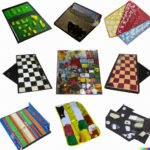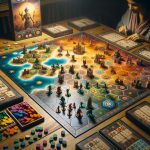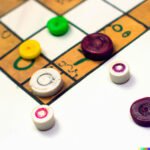Are you intrigued by the intricacies of turn based strategy board games and eager to create your own? In this article, we will delve into the various aspects involved in the process of designing and developing a turn based strategy board game. From understanding their appeal to learning about research, game mechanics, design, prototyping, art, production, marketing, and distribution, we will cover all the essential steps to bring your game idea to life.
Turn based strategy board games have captivated players for decades with their complex decision-making, strategic planning, and immersive gameplay. Whether it’s leading armies into battle or managing resources to build a civilization, these games offer a unique form of entertainment that continues to attract enthusiasts from all walks of life.
If you’re eager to join the ranks of successful game designers and create your own captivating turn based strategy board game, then read on as we explore the key elements in bringing your vision to fruition.
Throughout this article, we will provide valuable insights and practical advice on how to conduct research and analysis of existing turn based strategy board games. Additionally, we will delve into the intricate mechanics that make these games engaging and challenging for players.
By the end of this journey, you’ll have a comprehensive understanding of what it takes to make turn based strategy board games that stand out in an increasingly competitive market. So get ready to embark on an exciting adventure that combines creativity, innovation, and strategic thinking.
Research and Analysis
When it comes to creating a turn-based strategy board game, it’s important to start by understanding what makes existing games successful. By studying and analyzing these games, you can gain valuable insights into the mechanics, themes, and elements that resonate with players. Here are some key steps on how to make turn-based strategy board games:
1. Research Existing Games: Start by researching and playing a variety of existing turn-based strategy board games. Take note of the different mechanics, themes, and player experiences that each game offers. Analyze the strengths and weaknesses of these games to understand what makes them engaging for players.
2. Identify Common Elements: As you study different turn-based strategy games, look for common elements that contribute to their success. This could include aspects such as resource management, variable player powers, asymmetric gameplay, or grid-based movement. By identifying these common elements, you can begin to understand what aspects are essential for a compelling turn-based strategy game.
3. Analyze Player Feedback: In addition to studying existing games firsthand, take the time to read reviews and gather feedback from other players. Understanding what players enjoy or dislike about certain turn-based strategy board games can provide valuable insights into what makes a game enjoyable and engaging.
By thoroughly researching and analyzing existing turn-based strategy board games, you can gain a deeper understanding of the key elements that contribute to their success. This knowledge will be essential as you move forward in creating your own unique and compelling game concept.
Game Mechanics
Turn-based strategy board games are known for their complex and intricate game mechanics, which are crucial in creating an engaging and challenging gameplay experience. Understanding the various elements involved in these games is essential when designing and developing your own turn-based strategy board game. Here, we will delve into the different aspects of game mechanics that you need to consider when creating a turn-based strategy board game.
First and foremost, one of the key components of turn-based strategy games is the concept of time management. Players are required to plan their moves carefully within a specific timeframe, which adds an element of strategic decision-making to the gameplay. This aspect should be carefully balanced to ensure that it is challenging without being overly restrictive.
Additionally, resource management is another fundamental element in turn-based strategy board games. Whether it’s currency, supplies, or units, players must effectively manage their resources to progress through the game and achieve their objectives. Finding a good balance between scarcity and abundance can help create a compelling gameplay experience that keeps players engaged.
Furthermore, the inclusion of combat and tactics is integral to the core mechanics of turn-based strategy games. Balancing offensive and defensive strategies, as well as incorporating unique abilities and powers for different units or characters, can add layers of complexity to the gameplay. These elements contribute to creating a dynamic and strategic gaming experience that challenges players to think critically about their every move.
| Elements | Description |
|---|---|
| Time Management | Players must plan their moves within a specified timeframe. |
| Resource Management | Players need to effectively manage currency, supplies, or units. |
| Combat and Tactics |
Game Design
Creating a concept and theme for your turn-based strategy board game is a crucial step in the game design process. It sets the tone and atmosphere for your game, and helps guide all other aspects of its development. Here are some steps to consider on how to make turn-based strategy board games:
1. Identify Your Target Audience: Before diving into creating a concept and theme, it’s important to understand who your target audience is. Are you designing a game for hardcore strategy gamers, casual players, or families? Understanding your audience will help you tailor your concept and theme to appeal to them.
2. Brainstorm Unique Ideas: When creating the concept and theme for your board game, brainstorm unique ideas that set your game apart from existing ones in the market. Consider different historical eras, fantasy worlds, or futuristic settings that could serve as the backdrop for your game.
3. Integrate Theme with Mechanics: Once you have a concept and theme in mind, it’s essential to ensure that they are integrated seamlessly with the game mechanics. The mechanics of your game should reflect and enhance the theme, creating an immersive experience for players.
4. Develop Engaging Storylines: If your turn-based strategy board game incorporates story elements, focus on developing engaging storylines that tie into the overall theme. Whether it’s a quest for world domination or a struggle for survival in a post-apocalyptic setting, strong narratives can add depth and excitement to your game.
By following these steps on how to make turn-based strategy board games when creating a concept and theme for your game, you can lay a solid foundation for an exciting and engaging gaming experience. Remember to allow room for creativity while also considering what will resonate with your target audience.
Prototyping and Playtesting
Developing a turn-based strategy board game involves a crucial stage known as prototyping and playtesting. This phase is where your game idea starts to take shape and becomes a playable prototype for testing and refining. In this section, we will discuss the key steps on how to make turn-based strategy board games come to life through prototyping and playtesting.
The first step in creating a playable prototype is to translate your game concept into physical components such as cards, dice, game boards, and tokens. This can be done using basic materials like paper, cardboard, or even 3D printed pieces. The goal is to create a functional version of your game that allows players to understand the mechanics and test the gameplay.
Once you have created the prototype, it’s time to gather a group of playtesters to try out the game. These playtesters can provide valuable feedback on different aspects of the game such as rules clarity, balance, player interaction, and overall enjoyment. It’s important to observe their reactions and take note of any issues or suggestions for improvement. Making adjustments based on playtest feedback is an essential part of refining your turn-based strategy board game.
Finally, after several rounds of playtesting and iterating on your prototype, you can start considering elements such as artwork, graphic design, and layout. These visual elements are crucial in enhancing the overall appeal of your game and drawing in potential players. By following these steps in prototyping and playtesting, you can further develop your game idea into a polished and engaging turn-based strategy board game.
| Prototyping Steps | Playtesting Importance |
|---|---|
| Translate concept into physical components | Provides valuable feedback |
| Gather group of playtesters | Helps in observing reactions |
| Iterate based on feedback | Essential for refining the game |
Art and Graphics
Creating a visually appealing and engaging board game is essential to capturing the attention of potential players. The art and graphics of a turn-based strategy board game play a crucial role in immersing players in the game’s theme and story. From the game board and player pieces to the cards and rulebook, every visual element should be carefully designed to enhance the overall gaming experience.
Concept Art and Theme
Before diving into the actual artwork, it’s important to establish a clear concept and theme for your board game. Consider what kind of atmosphere you want to create – whether it’s a fantasy world, a historical setting, or a futuristic universe. Develop concept art that reflects the aesthetic and mood you want to convey in your game. This will serve as the visual foundation for all other design elements.
Illustration and Graphic Design
Once you have a solid concept in place, it’s time to bring your ideas to life through illustration and graphic design. Whether you’re working with an artist or tackling the visuals yourself, pay close attention to detail, color choices, and composition. Every aspect of the artwork should complement the gameplay mechanics and narrative of your turn-based strategy board game.
Component Design
In addition to creating stunning visuals for the game board itself, don’t overlook the design of player pieces, cards, tokens, and any other components. Each element should be thoughtfully crafted to not only look good but also function effectively during gameplay. Consider how these visual elements can contribute to strategic decision-making and enhance player engagement throughout the game.
By focusing on art and graphics that are both aesthetically pleasing and thematically appropriate, you can create an immersive gaming experience that captivates players from start to finish.
Production and Manufacturing
When it comes to production and manufacturing of turn based strategy board games, there are several key considerations to keep in mind. From choosing the right materials to finding a manufacturer, this stage is crucial in bringing your game to life.
Materials and Components
One of the first steps in the production process is deciding on the materials and components that will be used in your game. This includes everything from the game board and pieces to cards, dice, and any other accessories. It’s important to carefully consider the quality and durability of these components, as they will greatly impact the overall experience of the game for players.
Manufacturer Selection
Finding the right manufacturer for your turn based strategy board game is essential. Research different manufacturers and obtain quotes for production costs. Consider factors such as location, cost, minimum order quantities, and lead times. Ask for samples of their previous work to ensure their quality meets your standards.
Quality Control
Once you’ve selected a manufacturer, it’s important to establish clear communication and expectations regarding quality control. Regular communication throughout the manufacturing process is necessary to address any issues that may arise. Conduct thorough inspections of prototypes and final products to ensure they meet your standards before mass production begins.
By understanding how to navigate the production and manufacturing process for turn based strategy board games, you can bring your creative vision to life while ensuring a high-quality end product that will delight players.
Marketing and Distribution
After putting in all the hard work of creating a turn-based strategy board game, the next step is to ensure that it reaches the right audience. Marketing and distribution are crucial aspects of making sure that your game gets the attention it deserves. Here’s a guide on how to effectively promote and sell your board game.
First, you need to identify your target audience. Understanding who would be interested in playing your turn-based strategy board game will help you tailor your marketing efforts towards reaching them. Whether it’s casual gamers, hardcore tabletop enthusiasts, or a specific age group, knowing your audience will allow you to create targeted marketing campaigns.
Utilize various marketing channels to spread the word about your game. This could include social media advertising, email newsletters, influencer partnerships, and attending gaming conventions or trade shows. Creating engaging content such as tutorial videos, gameplay demos, or behind-the-scenes glimpses into the creation of your game can also generate interest and anticipation among potential players.
Additionally, consider different distribution options for selling your board game. You can sell directly through your own website or online marketplace platforms like Amazon or Etsy. Alternatively, approaching local game stores for consignment sales or seeking a partnership with a larger distributor can help get your game on shelves in more locations. By effectively marketing and strategically distributing your turn-based strategy board game, you can increase its visibility and attract a loyal fanbase.
Conclusion
In conclusion, the process of creating turn based strategy board games is an intricate and rewarding journey that requires a combination of innovation and creativity. By understanding the appeal of these games and studying existing ones, game designers can identify the elements that make these games successful and engaging. Through careful research and analysis, game designers can determine what works and what doesn’t in order to create a unique and enjoyable gaming experience.
Game mechanics play a crucial role in turn based strategy board games, as they determine the rules and interactions within the game. By exploring different elements such as resource management, unit abilities, and victory conditions, designers can create strategic depth and complexity that will keep players engaged. Furthermore, designing the visual elements of the game through art and graphics is essential in creating an immersive experience for players.
Ultimately, when bringing turn based strategy board games to life, it’s important to prioritize innovation and creativity. While following some industry standards can be beneficial, injecting fresh ideas into game design can set a game apart from others in the market.
By staying true to these values throughout each stage of development – from concept creation to manufacturing – designers can create truly exceptional turn based strategy board games that will captivate players for years to come. So if you’re interested in learning how to make turn based strategy board games, remember that embracing your creativity is key.
Frequently Asked Questions
How Do You Create a Turn-Based Strategy?
Creating a turn-based strategy game involves careful planning and consideration of game mechanics. Developers need to design the rules of the game, including how players take turns, move their pieces, and make strategic decisions.
What Makes a Good Turn Based Strategy Game?
A good turn-based strategy game is one that offers deep and engaging gameplay. It should provide players with meaningful choices, a balanced challenge, and a sense of progression. The game should also have well-designed AI and a clear set of rules.
How Do You Create a Game Strategy?
To create a game strategy, players need to assess the strengths and weaknesses of their resources and opponents. This involves analyzing the game’s objectives, understanding the available options, predicting outcomes, and adapting tactics based on evolving situations. Successful strategies require flexibility and creativity.

I love playing all kinds of games – from classics like Monopoly to modern favourites like Ticket to Ride.
I created this blog as a way to share my love of board games with others, and provide information on the latest releases and news in the industry.





